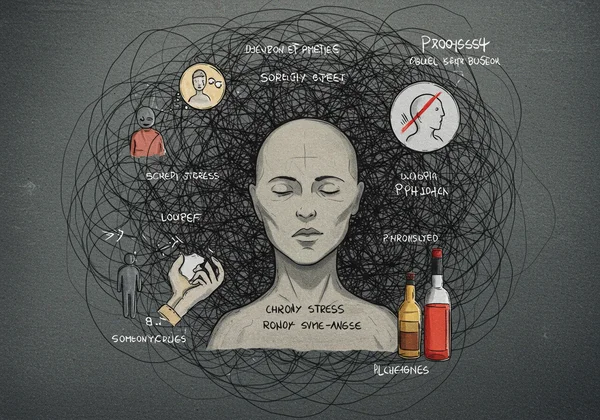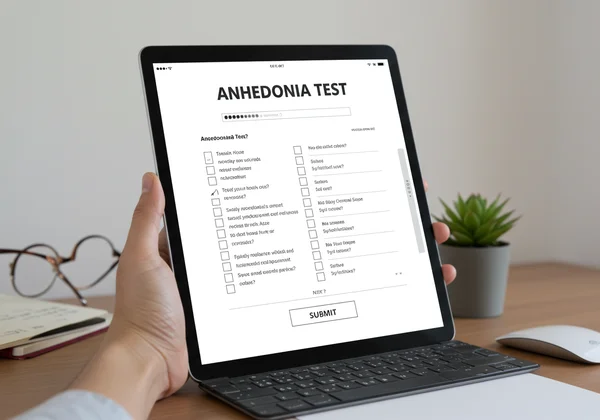Anhedonia Test FAQs: Your Top Questions & Myths Debunked
Feeling emotionally numb or finding it hard to enjoy the things you once loved can be a perplexing and isolating experience. This condition, known as anhedonia, often leaves people with more questions than answers. It's a journey that requires clarity, compassion, and understanding. If you find yourself asking, "Does anhedonia ever go away?" or are searching for a reliable anhedonia test, you've come to a place of support and insight. This article is here to answer your most pressing questions and debunk common myths, offering a clearer path forward.
Anhedonia is more than just feeling down; it's a profound loss of the ability to experience pleasure. To rediscover joy, the first crucial step is understanding anhedonia's complexities. A confidential assessment can provide valuable insights into your emotional well-being. If you're ready for clarity, you can start your journey to gain a better understanding of your feelings.
Does Anhedonia Ever Go Away? Understanding Prognosis
One of the most urgent questions people have is whether anhedonia is a permanent state. The encouraging answer is that for many, anhedonia can and does improve. Recovery is not only possible but common, though the path is unique for each individual. It is not a passive process but an active journey of rediscovery, often requiring a combination of strategies tailored to your specific situation.
Seeing anhedonia not as a life sentence but as a treatable symptom is a powerful shift in perspective. The prognosis often depends on addressing its root causes and actively engaging in strategies that help retrain the brain's reward system. With the right support and tools, you can move toward a life filled with more pleasure and connection.
Factors Influencing Recovery: What Helps Improve Anhedonia?
Several key factors can significantly influence recovery from anhedonia. A multi-faceted approach is often the most effective. Professional guidance from a therapist or counselor can provide structured support, with therapies like Cognitive Behavioral Therapy (CBT) and Behavioral Activation being particularly helpful. These approaches help you identify and change patterns of thought and behavior that contribute to emotional numbness.
Lifestyle adjustments also play a critical role in recovery factors. Regular physical exercise, a balanced diet rich in nutrients that support brain health, and consistent sleep hygiene can create a strong foundation for mental well-being. Furthermore, engaging in mindfulness practices can help you reconnect with the present moment and your senses, gradually rebuilding the pathways to pleasure.

Navigating Relapses and Long-Term Management Strategies
The path to recovery may include setbacks, and that's perfectly normal. Navigating potential relapses is a part of long-term management. The key is to build resilience and have a plan in place. This can involve recognizing your personal triggers and early warning signs of returning symptoms.
Developing a consistent routine that includes enjoyable activities, even if they don't bring immediate pleasure, is a core strategy. This practice, known as behavioral activation, helps re-establish the connection between actions and rewards in the brain. Keeping a journal to track your moods and progress can also provide valuable insights and a sense of accomplishment. To better understand your starting point, taking an anhedonia quiz can be a helpful tool.
What Worsens Anhedonia? Identifying Triggers and Habits
Understanding what can exacerbate anhedonia is just as important as knowing how to improve it. By identifying triggers and unhelpful habits, you can empower yourself to make conscious choices that support your emotional health. Often, factors that seem unrelated can have a significant impact on your ability to experience pleasure.
This awareness empowers you to proactively protect your well-being. It's about learning to navigate your environment and internal state in a way that fosters healing rather than deepens the feeling of numbness. Recognizing these patterns is a vital part of managing the signs of anhedonia.
Lifestyle Factors Impacting Pleasure Deficiency
Certain lifestyle factors can significantly contribute to a state of pleasure deficiency. Chronic stress is a primary culprit, as it floods the body with cortisol, a hormone that can interfere with the brain's reward circuits over time. Similarly, prolonged social isolation can starve the brain of the positive feedback it gets from connection, worsening feelings of detachment.
Substance use, particularly alcohol or other depressants, can also worsen anhedonia. While they may offer a temporary escape, they ultimately numb emotions further and can disrupt the delicate brain chemistry required for feeling joy. A lack of restorative sleep and a poor diet can also drain your physical and mental energy, making it even harder to engage with the world.

The Role of Stress and Co-occurring Conditions on Anhedonia
Anhedonia rarely exists in a vacuum. It is a core symptom of several mental health conditions, most notably anhedonia depression, but also schizophrenia, PTSD, and some anxiety disorders. Unmanaged stress and these co-occurring conditions can create a feedback loop, where the condition worsens anhedonia, and anhedonia makes the condition harder to manage.
Therefore, treating the underlying condition is paramount. A comprehensive approach that addresses the root cause is essential for lasting relief from anhedonia. If you suspect your feelings of numbness are linked to another condition, a free online screening can offer a starting point for a conversation with a healthcare professional.
Can People with Anhedonia Cry or Laugh? Understanding Emotional Expression
A common and confusing aspect of anhedonia is its effect on emotional expression. People often wonder, can people with anhedonia cry or laugh? The answer is yes, but the internal experience is often very different. The external act of laughing or crying might occur, but the corresponding internal feeling of joy or profound sadness may be blunted or absent entirely.
This disconnect can be disorienting. You might laugh at a joke because you recognize it's funny, but you don't feel the warmth or mirth spreading through you. Similarly, you might shed tears in a sad situation, but feel a hollow emptiness instead of the release of grief. This highlights the core of anhedonia: the disconnect from the rewarding aspect of emotions.
Nuances of Emotional Numbness: Beyond Sadness and Joy
The experience of emotional numbness is complex. It's not simply the absence of happiness, but a flattening of the entire emotional landscape. The vibrant colors of your feelings fade to gray. Positive emotions lose their rewarding quality, and negative emotions can lose their sharp, informative edge, leaving behind a dull ache or nothing at all.
This state goes beyond just feeling sad. Sadness is an active, often painful, emotion. Emotional numbness is a void where those feelings used to be. Understanding this distinction is crucial for both those experiencing it and their loved ones, as it validates that this is a genuine symptom, not just a bad mood.

How Anhedonia Affects Social Interactions and Connections
Anhedonia has a profound impact on social interactions. When you no longer derive pleasure from connecting with others—a condition known as social anhedonia—socializing can feel like a chore. Conversations may seem pointless, and the company of friends and family may fail to provide the comfort it once did.
This often leads to social withdrawal, which unfortunately worsens the problem. Humans are wired for connection, and isolation can deepen feelings of emptiness and detachment. Recognizing this pattern is the first step to breaking the cycle. If you feel this way, it may be helpful to take a free assessment to better understand your experience with social anhedonia.
Debunking Common Anhedonia Myths and Misconceptions
Misinformation about anhedonia can lead to shame, guilt, and confusion. Addressing anhedonia myths is essential for fostering a compassionate and accurate understanding of the condition. Clearing up these misconceptions helps validate the experiences of those struggling and provides a clearer path toward seeking appropriate support.
Anhedonia vs. Laziness or Sadness: A Clear Distinction
One of the most harmful myths is confusing anhedonia vs. laziness or sadness. Laziness is a lack of willingness to exert oneself, whereas anhedonia is a lack of ability to feel pleasure from activities. Someone with anhedonia may desperately want to enjoy something but find themselves physically and emotionally unable to.
Similarly, while anhedonia is often linked to depression, it is distinct from sadness. Sadness is an emotion, while anhedonia is the impairment of the capacity to feel a range of emotions, especially pleasure. A person can feel sad without having anhedonia, and some people with anhedonia report not feeling sad, but rather, feeling nothing at all.
Is Anhedonia Brain Damage? Addressing Underlying Concerns
The question, "Is anhedonia brain damage?", often comes from a place of deep fear. The simple answer is no, anhedonia is not considered brain damage in the way a traumatic brain injury is. However, it is linked to changes in how the brain functions, specifically within its reward system.
Neurotransmitters like dopamine, which are crucial for motivation and pleasure, may not be functioning optimally. Research shows that these brain pathways can change and be re-regulated through therapy, lifestyle changes, and sometimes medication. This understanding shifts the focus from irreversible damage to a hopeful prospect of healing and recovery.
Ready for Clarity? Explore Anhedonia with a Confidential Test
Navigating the fog of anhedonia is challenging, but you don't have to do it alone. Understanding what anhedonia is, what worsens it, and how it truly feels is a monumental step toward reclaiming your life. This knowledge empowers you to seek the right kind of support and to be compassionate with yourself through the process.
If you recognize yourself in these descriptions, gaining personal insight is the next logical step. Our platform offers a free, confidential, and science-based anhedonia test, developed from clinically recognized scales like the Snaith-Hamilton Pleasure Scale (SHAPS). It's designed to give you a clear, instant summary of your symptoms without requiring any registration.
Take the next step toward rediscovering your capacity for joy. Try our free tool today to get confidential, personal insights. We encourage you to share your thoughts or questions in the comments below to connect with a community of understanding.

Frequently Asked Questions About Anhedonia
How is Anhedonia typically assessed or diagnosed?
A formal diagnosis is made by a mental health professional, such as a psychiatrist or psychologist. The process typically involves a detailed clinical interview to understand your symptoms and history. They may also use standardized psychological questionnaires, like the SHAPS, to measure the severity of pleasure impairment. An online screening tool can be a valuable first step, providing you with a baseline to discuss with a professional. A great starting point is an accessible SHAPS based quiz like the one we offer.
What is often considered the root cause of Anhedonia?
There is no single "root cause" of anhedonia. It is generally understood to result from a complex interplay of factors. These can include biological components, like dysregulation in the brain's dopamine system; psychological factors, such as chronic stress, trauma, or depression; and social or environmental influences, like prolonged isolation. Addressing anhedonia often requires looking at all these potential contributors.
What are the symptoms of social anhedonia?
The symptoms of social anhedonia revolve around a lack of pleasure from interpersonal situations. Key signs include a reduced interest in socializing with friends or family, not seeking out social activities, feeling detached or indifferent during conversations, and preferring to be alone not for restorative peace but because social contact feels unrewarding or draining.
Do people with Anhedonia experience any positive emotions at all?
Yes, it's possible, but the experience is typically muted. A person with anhedonia might have a fleeting moment of contentment or a flicker of interest, but it lacks the depth, richness, and rewarding quality of a full emotional experience. The profound sense of joy, excitement, or deep satisfaction is what's largely missing, leading to the overall feeling of emotional flatness.